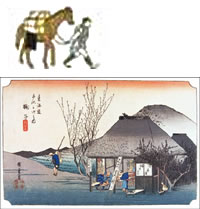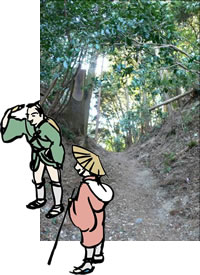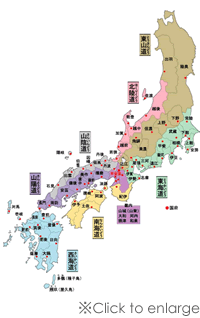Top Page > About Tokaido and Shukuba

■What is Tokaido?
Around the 7th century, Japan was divided into 12 administrative regions. Tokaido was one of these administrative regions. During the 17th century, Tokugawa Ieyasu created a variety of infrastructure to facilitate the transport of people, information, and goods and roads for the use by the military. Shukuba post-station towns were among the things he created.
There were 57 Shukuba post-station towns in Tokaido and there was a system to transport letters and packages along the post-station towns in a relay fashion. Shukuba served as a center of information and knowledge and where the culture flourished and spread. In Japan, walking tours to visit the old Shukuba is gaining popularity.
- Tokaido started in Nihonbashi in Edo (Tokyo). It ended in Moriguchi in Osaka.
- Tokyo was called “Edo” until the late 19th century.
- Each Shukuba had a number. No.1 was Shinagawa-shuku (Tokyo) and No. 57 was the Moriguchi-shuku (Osaka).
- Hiroshige Ando was an artist during the Edo period, who depicted the landscape of Tokaido. There are many artists who create print pieces.
■Edo period/Kaido road
- In Japanese, ancient highways/roads are collectively called “Kaido.”
- In Japanese history, 1603 ? 1867 is referred to as the Edo period. Edo period was followed by the Meiji period (1868 ? 1912), Taisho period (1912 ? 1926), Showa period (1926 ? 1989), and we are currently in the Heisei period.
- An average adult male can walk about 40 km per day. It took 14 ? 17 days to travel from Edo to Osaka.
- Tokugawa Ieyasu was a Shogun, who created the Edo Bakufu (government) in the 17th century, and the Tokugawa clan peacefully ruled Japan for the following 260 years. Ieyasu was interested in diplomacy and managed to establish a relationship with Korea. When the ruling Shogun changed, envoys from Korea were invited as the guest of the state. These Korean envoys visited Japan for a total of 12 times.
■What is Tokaido Goju Nana Tsugi?
At the time, official letters and packages were not carried by the same person or horse from the origin to the destination. They were transported in a relay fashion and thus each Shukuba was ready with the necessary personnel and horses to safely carry the items to the next Shukuba . Shukuba in Tokaido had 100 deliverers and 100 horses ready to go. Additionally, Shukuba were equipped to accommodate
Daimyo (feudal lords) and other travelers to stay overnight or simply to take a break.
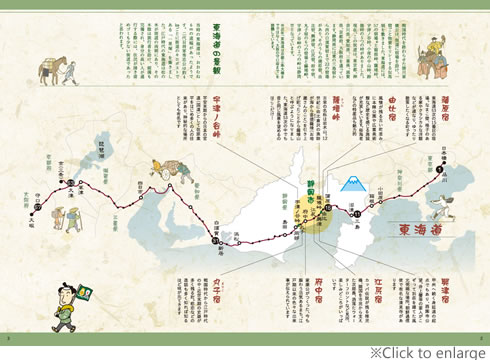

■What is Shukuba?
Of the 57 Shukuba post-station towns in Tokaido, 6 are in Shizuoka City. Take a walking tour of the Shukuba to experience Japan from the olden days.
■What is Toge(Pass)?
Toge refers to the highest part of the mountain path. In the ancient times, Toge was used to mark the boundary between one’s own land and the foreign land and people either prayed for a safe journey ahead, when traveling beyond, or expressed gratitude for a safe return, when traveling back. The small shrine (Hokora) placed at Toge served as the place for this type of worship and also as a barrier to prevent
malicious things from coming in from beyond the border.
■Guide: Jippensha Ikku
In the 18th century, books about traveling and unique features of Shukuba became very popular, leading to a travel boom. The author of these books, Jippensha Ikku, was born and raised in Shizuoka. He is the mascot character of Suruga Aindo.
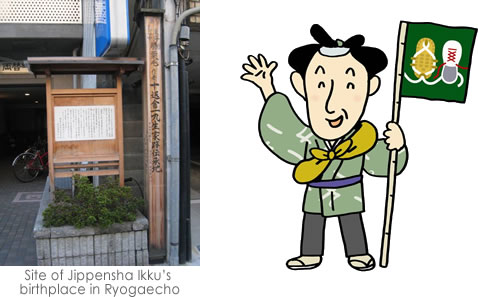
■What is Suruga Aindo?
6 of the 57 Shukuba post-station towns along Tokaido (Kambara-shuku, Yui-shuku, Okitsu-shuku, Ejiri-shuku, Fuchu-shuku, Mariko-shuku) are located in Shizuoka City. “Suruga Aindo” is a walking course to enjoy these Shukuba and famously challenging “Satta Pass” and “Utsunoya Pass.” 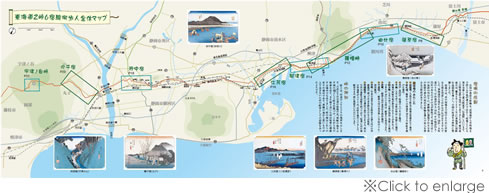

|










